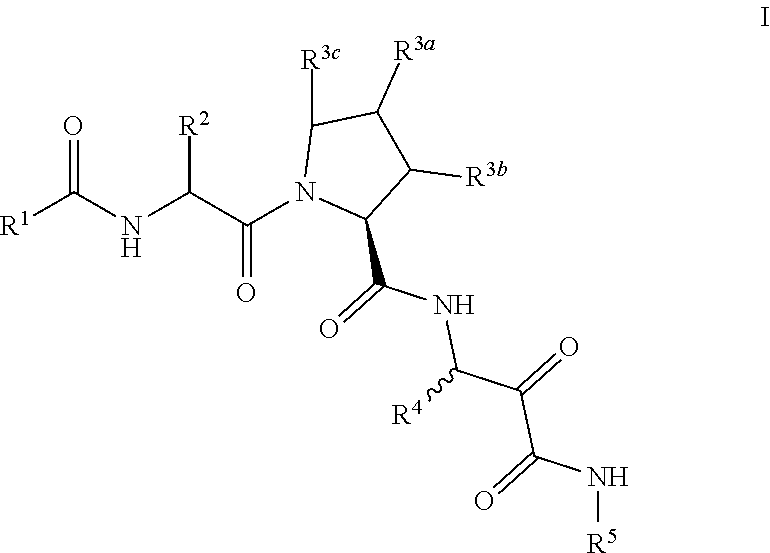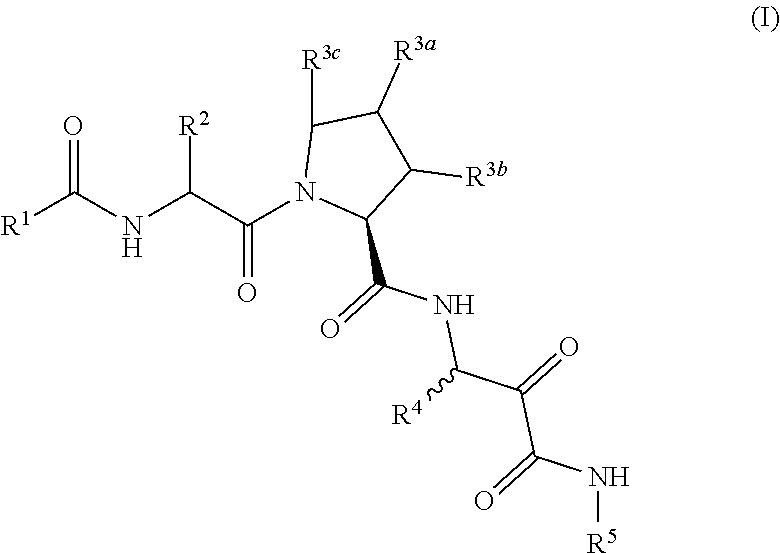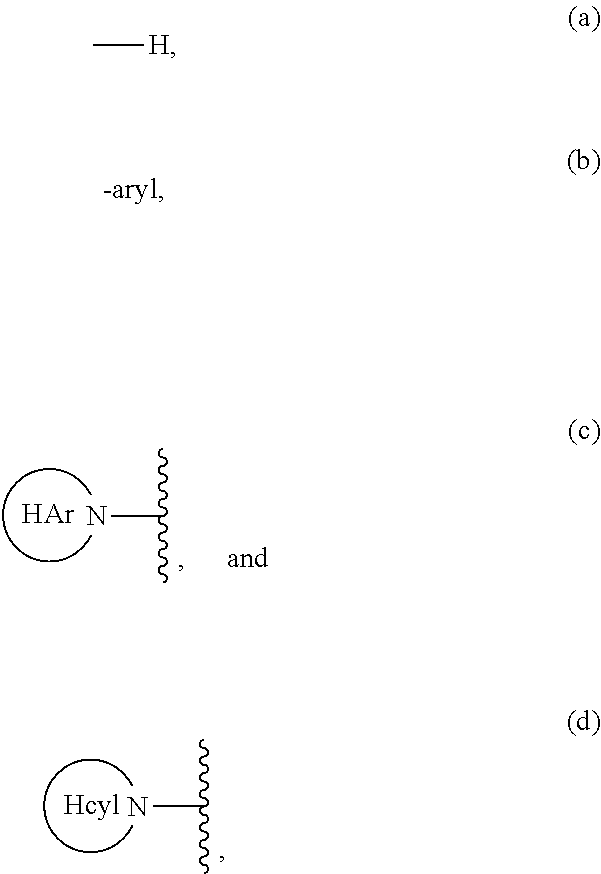Aliphatic prolinamide derivatives
a technology of aliphatic prolinamide and derivatives, which is applied in the field of aliphatic prolinamide derivatives, can solve the problems of difficulty in distinguishing between iris pigmentation alone and other, increase the risk of amd, and affect vision, so as to prevent and treat diseases, inhibit the activity of htra1 proteas
- Summary
- Abstract
- Description
- Claims
- Application Information
AI Technical Summary
Benefits of technology
Problems solved by technology
Method used
Image
Examples
example 1
R)-2-(2-Naphthamido)-3-cyclohexylpropanoyl)-N-(1-amino-4-methyl-1,2-dioxopentan-3-yl)pyrrolidine-2-carboxamide
[0721]
Step 1: Preparation of methyl ((R)-2-((tert-butoxycarbonyl)amino)-3-cyclohexylpropanoyl)-L-prolinate
[0722]Into a 100 mL round-bottom flask, equipped with a magnetic stir bar and under nitrogen was added (R)-2-((tert-butoxycarbonyl)amino)-3-cyclohexylpropanoic acid (2.05 g, 7.6 mmol, 1.0 equiv), HATU (4.31 g, 11.3 mmol, 1.5 equiv) and CH2Cl2 (20 mL). The suspension was stirred at room temperature for 30 minutes and then L-proline methyl ester hydrochloride (1.50 g, 9.1 mmol, 1.2 equiv) was added followed by EtN(iPr)2 (2.6 mL, 15.1 mmol, 2 equiv). The resulting light yellow solution was stirred at room temperature for 18 h overnight. The reaction mixture was poured into a 250 mL separatory funnel containing 1 M aqueous HCl solution (100 mL) and extracted with CH2Cl2 (3×40 mL). The combined organic layers were washed with brine (50 mL), dried over MgSO4, filtered and conc...
example 2
-((S)-1-((R)-2-(2-naphthamido)-3-cyclohexylpropanoyl)pyrrolidine-2-carboxamido)-4-methyl-2-oxopentanoyl)glycinate
[0729]
Step 1: Preparation of methyl 3-(((benzyloxy)carbonyl)amino)-2-hydroxy-4-methylpentanoate
[0730]Into a 200 mL round-bottom flask equipped with a magnetic stir bar and reflux condenser was added benzyl (1-cyano-1-hydroxy-3-methylbutan-2-yl)carbamate (Intermediate A, Step 3, 2.6 g, 10.0 mmol, 1.0 equiv) and MeOH (50 mL). Into the reaction mixture was bubbled in HCl (gas) via a fritted glass tube. The mixture was kept under an atmosphere of HCl (gas) and heated to reflux for 24 h. At this time, LCMS analysis revealed no remaining starting material. The reaction mixture was cooled to room temperature and concentrated under reduced pressure to afford a yellow oil which was used directly in the next step without further purification.
Step 2: Preparation of methyl 3-amino-2-hydroxy-4-methylpentanoate
[0731]Into a 100 mL round-bottom flask equipped with a magnetic stir bar and...
example 4
-((R)-2-(2-naphthamido)-3-cyclohexylpropanoyl)-N-(1-amino-4-methyl-1,2-dioxopentan-3-yl)-4-phenylpyrrolidine-2-carboxamide
[0738]
Step 1: Preparation of tert-butyl (2S,4R)-2-((1-amino-2-hydroxy-4-methyl-1-oxopentan-3-yl)carbamoyl)-4-phenylpyrrolidine-1-carboxylate
[0739]A round-bottom flask was charged with (2S,4R)-1-(tert-butoxycarbonyl)-4-phenylpyrrolidine-2-carboxylic acid (88 mg, 0.3 mmol, 1.0 equiv), 3-amino-2-hydroxy-4-methylpentanamide hydrochloride (Intermediate A, 44 mg, 0.3 mmol, 1.0 equiv), HATU (125 mg, 0.33 mmol, 1.1 equiv) and CH2Cl2 (3 mL). The reaction was treated with EtN(iPr)2 (104 μL, 0.6 mmol, 2.0 equiv) and stirred at room temperature for 1 h. The reaction was diluted with CH2Cl2 and poured into a 125 mL separatory funnel and washed with 0.5 M aqueous HCl solution (25 mL), sat. aqueous NaHCO3 solution (25 mL), brine (25 mL), dried over MgSO4, filtered and concentrated under reduced pressure. Purification by column chromatography through silica gel, eluting with 100...
PUM
| Property | Measurement | Unit |
|---|---|---|
| pH | aaaaa | aaaaa |
| flow rate | aaaaa | aaaaa |
| temperature | aaaaa | aaaaa |
Abstract
Description
Claims
Application Information
 Login to View More
Login to View More - R&D
- Intellectual Property
- Life Sciences
- Materials
- Tech Scout
- Unparalleled Data Quality
- Higher Quality Content
- 60% Fewer Hallucinations
Browse by: Latest US Patents, China's latest patents, Technical Efficacy Thesaurus, Application Domain, Technology Topic, Popular Technical Reports.
© 2025 PatSnap. All rights reserved.Legal|Privacy policy|Modern Slavery Act Transparency Statement|Sitemap|About US| Contact US: help@patsnap.com



